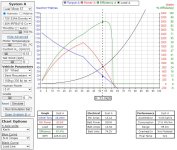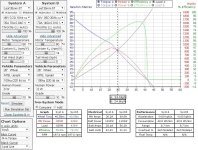John in CR said:Slow wind motors are fine for those who are positive they never go faster, however, they are easier to push to heat failure on long hills because even relatively low power controllers can push enough current through their far higher resistance windings.
OK, back to the simulator. Hm, it looks to me like at any reasonable speed, that 2707 goes farther before it overheats, than the 2705. Also at unreasonable speeds, and at unreasonable grades. At 8% full throttle, 52V x 20A controller, the 2707 goes 5 miles, the 2705 3 miles. At 5% grade, they 2705 runs a little hotter and slower. At 20A, to see the benefit from the 2705 even on level ground, I have to switch to the "full recumbent" setting. At 35A I can get 2705 speed on the flats on an upright, and they can run pretty ridiculous grades at very comparable outcomes, but the 2707 always pulls a little ahead on the hills.
I can't find the setting where "they are easier to push to heat failure on long hills", so I can't say for sure what that's about, but I hope you aren't playing the same game he does with his "Plus you can cruise at full throttle at a speed that makes sense for a bicycle" (I mean, I don't know, maybe someone craves the setup that will routinely be operated at full throttle, but as the simulator itself puts it, "that is not usually representative of how people ride an ebike.")
Isn't it really about what size of wheel? If you have a 20 inch wheel, then you'd certainly want the fast wiring, while the higher count is for a 26" or 700c wheel?



